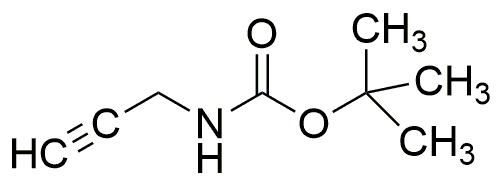N-(tert-Butoxycarbonyl)propargylamine is widely utilized in research focused on:
- Pharmaceutical Development: This compound serves as an important intermediate in the synthesis of various pharmaceuticals, particularly in the development of novel drugs targeting neurological disorders.
- Organic Synthesis: It is commonly used in organic chemistry for the preparation of more complex molecules, allowing researchers to create compounds with specific functionalities efficiently.
- Bioconjugation: The chemical is valuable in bioconjugation processes, where it helps in attaching biomolecules to surfaces or other molecules, enhancing drug delivery systems.
- Material Science: In the field of material science, it can be utilized to modify polymers, improving their properties for applications in coatings and adhesives.
- Research in Catalysis: This compound plays a role in catalytic reactions, providing researchers with a tool to explore new catalytic pathways and improve reaction efficiencies.
Información general
Propiedades
Seguridad y normativas
Aplicaciones
N-(tert-Butoxycarbonyl)propargylamine is widely utilized in research focused on:
- Pharmaceutical Development: This compound serves as an important intermediate in the synthesis of various pharmaceuticals, particularly in the development of novel drugs targeting neurological disorders.
- Organic Synthesis: It is commonly used in organic chemistry for the preparation of more complex molecules, allowing researchers to create compounds with specific functionalities efficiently.
- Bioconjugation: The chemical is valuable in bioconjugation processes, where it helps in attaching biomolecules to surfaces or other molecules, enhancing drug delivery systems.
- Material Science: In the field of material science, it can be utilized to modify polymers, improving their properties for applications in coatings and adhesives.
- Research in Catalysis: This compound plays a role in catalytic reactions, providing researchers with a tool to explore new catalytic pathways and improve reaction efficiencies.
Documentos
Hojas de datos de seguridad (HDS)
La SDS proporciona información de seguridad completa sobre la manipulación, el almacenamiento y la eliminación del producto.
Especificación del producto (PS)
La PS proporciona un desglose completo de las propiedades del producto, incluida la composición química, el estado físico, la pureza y los requisitos de almacenamiento. También detalla los rangos de calidad aceptables y las aplicaciones previstas del producto.
Certificados de análisis (COA)
Busque certificados de análisis (COA) ingresando el número de lote del producto. Los números de lote y de partida se pueden encontrar en la etiqueta de un producto después de las palabras "Lote" o "Lote".
Número de catálogo
Número de lote/lote
Certificados de origen (COO)
Este certificado de origen confirma el país en el que se fabricó el producto y también detalla los materiales y componentes utilizados en él y si se deriva de fuentes naturales, sintéticas u otras fuentes específicas. Este certificado puede ser necesario para cumplir con las normativas aduaneras, comerciales y regulatorias.
Número de catálogo
Número de lote/lote
Hojas de datos de seguridad (HDS)
La SDS proporciona información de seguridad completa sobre la manipulación, el almacenamiento y la eliminación del producto.
DownloadEspecificación del producto (PS)
La PS proporciona un desglose completo de las propiedades del producto, incluida la composición química, el estado físico, la pureza y los requisitos de almacenamiento. También detalla los rangos de calidad aceptables y las aplicaciones previstas del producto.
DownloadCertificados de análisis (COA)
Busque certificados de análisis (COA) ingresando el número de lote del producto. Los números de lote y de partida se pueden encontrar en la etiqueta de un producto después de las palabras "Lote" o "Lote".
Número de catálogo
Número de lote/lote
Certificados de origen (COO)
Este certificado de origen confirma el país en el que se fabricó el producto y también detalla los materiales y componentes utilizados en él y si se deriva de fuentes naturales, sintéticas u otras fuentes específicas. Este certificado puede ser necesario para cumplir con las normativas aduaneras, comerciales y regulatorias.

